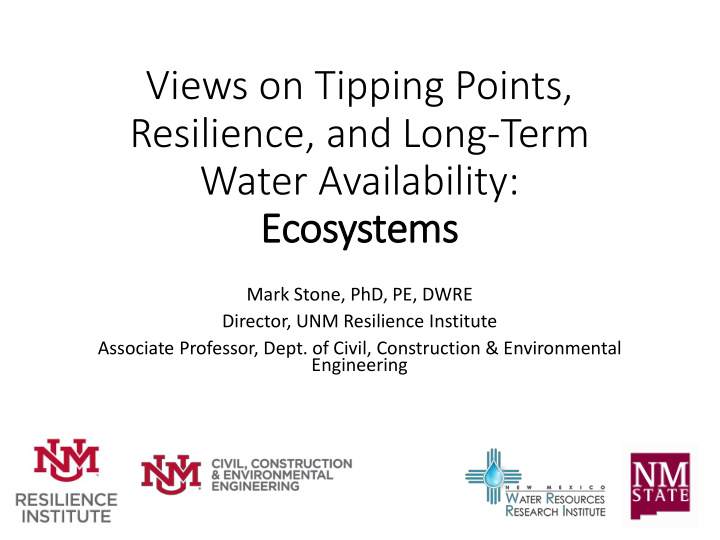



Views on Tipping Points, Resilience, and Long-Term Water Availability: Ecosy systems Mark Stone, PhD, PE, DWRE Director, UNM Resilience Institute Associate Professor, Dept. of Civil, Construction & Environmental Engineering
Social-ecological systems are complex, integrated systems in which humans are recognized as part of nature. (Berkes & Folke 1998) Organizations External External Use and Management of Drivers Drivers Natural Resources Social Ecological Sub-Systems Sub-Systems Internal People Biodiversity Economy Adaptations Water Infrastructure Land Etc. Etc. Delivery of Ecosystem Goods and Services
“Resilience is the capacity of a system to absorb disturbance and reorganize so as to retain essentially the same function, structure, and feedbacks— to have the same identity.” Walker and Salt, 2010
Specified resilience is the resilience of some specified part of the system to a specified shock— a particular kind of disturbance (wildfire, terrorist attack, flooding, etc.) General resilience is the capacity of a system that allows it to absorb disturbances of all kinds, including novel, unforeseen ones, so that all parts of the system keep functioning as they have in the past.
There are limits to how much a self-organizing system can be changed and still recover. Beyond those limits it functions differently because some critical feedback process has changed. thresholds. These limits are known as
Low Resilience High Resilience
Resilience practice is very much about thresholds— understanding them, determining where they might lie and what determines this, appreciating how you might deal with them, and having the capacity to be able to deal with them.
The Rio Chama Watershed
Streamflow upstream of El Vado Reservoir Streamflow downstream of El Vado Reservoir Summary of Changes: • • Lower spring peaks Higher summer and fall flows • • Higher variation in summer flows Higher variations in winter flows
The downstream system has adjusted to the new boundary condition and developed a novel ecosystem. Novel ecosystems are human-built, modified, or engineered systems. They exist in places that have been altered in structure and function by human agency. Downsized channel Stabilized banks Upland vegetation encroachment Introduced fishery (brown trout)
The Rio Chama Flows Project aims to inform water operations in order to achieve environmental improvements in the downstream reach without jeopardizing downstream water users.
Another System to Consider: Middle Rio Grande Bosque
Our headwater systems
Closing Thoughts • Resilience thinking requires a holistic view of socio- ecological systems • Managing for resilient systems requires an understanding of thresholds • Many/most/(all) of our ecosystems in the southwest are in a novel phase • Resilience practice provides a useful context for viewing and managing our novel systems
Recommend
More recommend